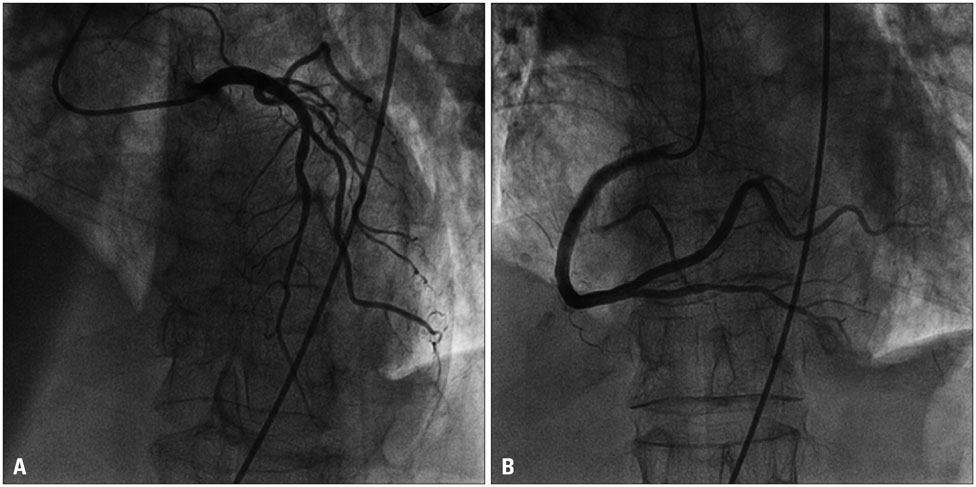J Cardiovasc Ultrasound.
2015 Sep;23(3):173-176. 10.4250/jcu.2015.23.3.173.
Ventricular Septal Rupture in a Case Suspected as Stress Induced Cardiomyopathy
- Affiliations
-
- 1Department of Cardiology, Dong-A University Hospital, Busan, Korea. thpark65@dau.ac.kr
- KMID: 2068727
- DOI: http://doi.org/10.4250/jcu.2015.23.3.173
Abstract
- An 87-year-old woman with continuous chest discomfort was referred to our hospital. ST-segment elevation in lead V1-4 was detected on electrocardiography and ventricular septal rupture (VSR) was observed on echocardiography. Post-acute myocardial infarction (AMI) VSR was suspected and she underwent emergency cardiac catheterization. However, coronary angiography showed normal coronary artery. On the fourth day after admission, the patient died. We suspect that VSR was developed by stress induced cardiomyopathy, not by AMI.
MeSH Terms
Figure
Reference
-
1. Prasad A. Apical ballooning syndrome: an important differential diagnosis of acute myocardial infarction. Circulation. 2007; 115:e56–e59.2. Gianni M, Dentali F, Grandi AM, Sumner G, Hiralal R, Lonn E. Apical ballooning syndrome or takotsubo cardiomyopathy: a systematic review. Eur Heart J. 2006; 27:1523–1529.
Article3. Akashi YJ, Goldstein DS, Barbaro G, Ueyama T. Takotsubo cardiomyopathy: a new form of acute, reversible heart failure. Circulation. 2008; 118:2754–2762.4. Ohara Y, Hiasa Y, Hosokawa S, Tomokane T, Yamaguchi K, Ogura R, Miyajima H, Ogata T, Yuba K, Suzuki N, Takahashi T, Kishi K, Ohtani R. Left ventricular free wall rupture in transient left ventricular apical ballooning. Circ J. 2005; 69:621–623.
Article5. Kumar S, Kaushik S, Nautiyal A, Choudhary SK, Kayastha BL, Mostow N, Lazar JM. Cardiac rupture in takotsubo cardiomyopathy: a systematic review. Clin Cardiol. 2011; 34:672–676.
Article6. Virani SS, Khan AN, Mendoza CE, Ferreira AC, de Marchena E. Takotsubo cardiomyopathy, or broken-heart syndrome. Tex Heart Inst J. 2007; 34:76–79.7. Sacha J, Maselko J, Wester A, Szudrowicz Z, Pluta W. Left ventricular apical rupture caused by takotsubo cardiomyopathy--comprehensive pathological heart investigation. Circ J. 2007; 71:982–985.
Article8. Izumi K, Tada S, Yamada T. A case of Takotsubo cardiomyopathy complicated by ventricular septal perforation. Circ J. 2008; 72:1540–1543.
Article9. Lee JW, Kim JY, Youn YJ, Sung JK, Lee NS, Lee KH, Yoo BS, Lee SH, Yoon J, Choe KH. Clinical characteristics and prognostic factors of stress-induced cardiomyopathy. Korean Circ J. 2010; 40:277–282.
Article
- Full Text Links
- Actions
-
Cited
- CITED
-
- Close
- Share
- Similar articles
-
- Rupture of Right Ventricular Free Wall Following Ventricular Septal Rupture in Takotsubo Cardiomyopathy with Right Ventricular Involvement
- A Case of Ventricular Septal Rupture in Stress Cardiomyopathy
- Stress-induced cardiomyopathy during ophthalmologic surgery: A case report
- A case of stress-induced cardiomyopathy with an "inverted Takotsubo" contractile pattern
- Left Ventricular Thrombus Associated with Takotsubo Cardiomyopathy: A Cardioembolic Cause of Cerebral Infarction




